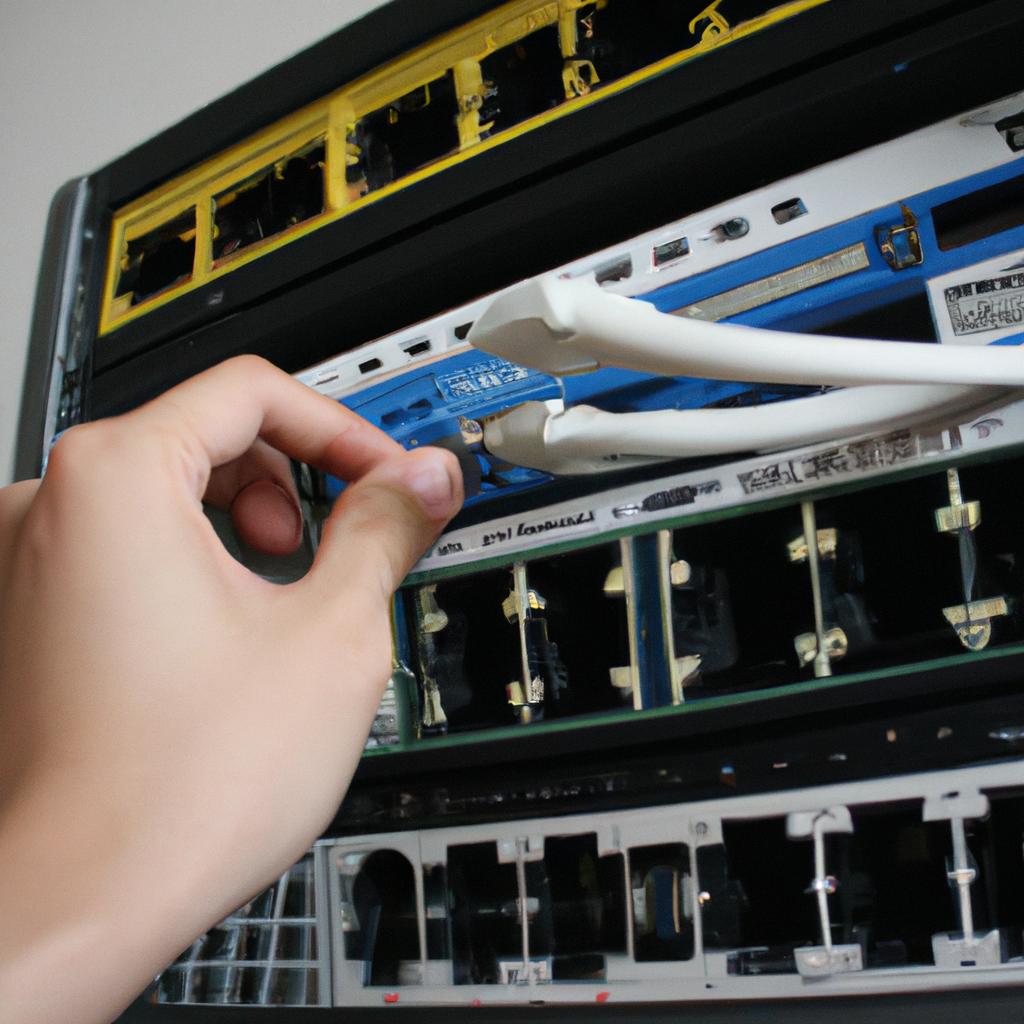Content caching is a critical technique that enhances web server performance by reducing the load on servers and decreasing response times for users. Squid Cache, an open-source caching proxy, has gained significant attention in recent years due to its ability to effectively cache static and dynamic content. This article aims to explore the benefits of utilizing Squid Cache as a content caching solution for web servers.
To illustrate the importance of content caching, consider a hypothetical scenario where a popular e-commerce website experiences heavy traffic during a flash sale event. Without proper caching mechanisms in place, every request made by users would have to be processed directly by the web server, leading to increased latency and potentially overwhelming the server’s capacity. However, with Squid Cache implemented, frequently accessed images, product descriptions, and other static elements can be stored locally within the cache memory. As a result, subsequent requests for these resources can be served quickly without burdening the underlying infrastructure. Thus, Squid Cache offers an efficient means of optimizing web server performance and ensuring smooth user experiences even during peak usage periods.
Why Squid Cache is important for web server performance
Squid Cache is an essential tool for enhancing web server performance through content caching. By storing frequently accessed data closer to the user, Squid Cache significantly reduces latency and improves overall browsing experience. This section will explore why Squid Cache is important for web server performance, highlighting its ability to optimize resource utilization, minimize network congestion, and enhance scalability.
To illustrate the impact of Squid Cache, consider a hypothetical scenario where a popular e-commerce website experiences high traffic during a flash sale event. Without caching mechanisms in place, each request made by users would result in multiple database queries and extensive processing on the web server. This increased load can lead to slower response times and potential service interruptions. However, with Squid Cache implemented, static resources such as product images, CSS files, and JavaScript libraries are cached at the edge server nearest to the user’s location. As a result, subsequent requests for these resources are served directly from cache memory rather than being fetched from the origin server every time.
One key advantage of using Squid Cache is its ability to optimize resource utilization. By serving cached content instead of repeatedly generating dynamic responses or accessing external databases, Squid Cache reduces CPU usage and minimizes disk I/O operations on the web server. Moreover, it allows for better utilization of available bandwidth by alleviating network congestion caused by repetitive requests for identical content.
The following bullet point list summarizes the benefits of Squid Cache:
- Improved page load times
- Reduced strain on backend servers
- Enhanced reliability and uptime
- Efficient handling of bursty traffic
In addition to optimizing resource utilization and minimizing network congestion, Squid Cache also enhances scalability by distributing workload across multiple caching servers when deployed in a clustered configuration. The table below illustrates this concept:
| Caching Server 1 | Caching Server 2 | Caching Server 3 |
|---|---|---|
| User A | User B | User C |
| User D | User E | User F |
| User G | User H | User I |
| … | … | … |
In this example, each caching server handles a subset of user requests, ensuring efficient utilization of resources and seamless scalability as the number of users increases.
By leveraging Squid Cache, web servers can significantly improve performance and deliver content more efficiently. In the subsequent section, we will delve into understanding the role of caching in improving web server performance, exploring its underlying mechanisms and benefits for both static and dynamic content delivery.
Understanding the role of caching in improving web server performance
Imagine a scenario where a popular e-commerce website experiences a sudden surge in traffic due to a flash sale. Without an efficient caching mechanism, the web server would struggle to handle the increased load, resulting in slow page loads and potential crashes. In this section, we will explore how caching plays a vital role in improving web server performance and why Squid Cache stands out as an effective solution.
The Role of Caching:
Caching is the process of storing frequently accessed data or content closer to the end-user, reducing the need for repeated requests to the origin server. By serving cached content directly from memory or disk, web servers can significantly enhance their performance. Here are some key reasons why caching is essential:
- Reduced Latency: Caching eliminates round-trips between clients and servers by delivering pre-fetched content locally. This reduces network latency and improves response times.
- Bandwidth Optimization: With caching, repetitive downloads of identical files can be avoided. Instead, users receive these files from their local cache, saving bandwidth both for end-users and upstream providers.
- Scalability Improvement: By offloading static resource delivery to caches like Squid Cache, web servers can focus more on processing dynamic requests. This enhances overall scalability by efficiently utilizing available resources.
- Enhanced User Experience: Faster loading times result in improved user experience, leading to higher customer satisfaction and increased engagement with websites.
Table: Comparison of Different Caching Solutions
| Solution | Pros | Cons |
|---|---|---|
| Squid Cache | High-performance proxy | Configuration complexity |
| CDN | Global distribution | Costly infrastructure setup |
| Browser Caches | Instant access without network calls | Limited control over expiration policies |
Exploring the benefits of Squid Cache in content delivery:
Squid Cache offers a comprehensive caching solution that excels in streamlining content delivery. In the following section, we will delve into the numerous advantages this powerful proxy cache provides and how it can significantly enhance web server performance.
With an understanding of the importance of caching established, let us now explore the benefits Squid Cache brings to content delivery.
Exploring the benefits of Squid Cache in content delivery
Understanding the role of caching in improving web server performance is crucial for organizations seeking to enhance their website’s speed and responsiveness. One prominent solution that has proven effective in this regard is Squid Cache, a widely used content caching software. To further explore the benefits of Squid Cache in content delivery, let us consider a hypothetical example.
Imagine a popular e-commerce website experiencing high traffic volumes during a major sale event. Without any caching mechanism in place, each user request would require the web server to fetch data from its backend database, resulting in increased load times and potential performance issues. However, by implementing Squid Cache, the web server can store frequently accessed content locally, reducing the need to repeatedly retrieve information from the database. This improves overall response time and ensures smoother browsing experiences for users even during peak usage periods.
One of the key advantages offered by Squid Cache includes:
- Improved scalability: By offloading repetitive requests from the backend servers to local caches, Squid allows websites to handle higher traffic loads without compromising on performance.
- Bandwidth optimization: With its ability to serve cached content directly from memory or disk storage, Squid reduces bandwidth consumption by minimizing redundant network transfers.
- Reduced latency: The proximity between users and Squid cache servers enables quicker retrieval of frequently accessed data, alleviating latency concerns associated with distant database retrievals.
- Enhanced fault tolerance: In case of backend server failures or maintenance activities, Squid Cache seamlessly continues serving previously cached content until regular operations are restored.
To highlight these benefits visually, consider the following table showcasing how Squid Cache positively impacts various aspects of web server performance:
| Performance Aspect | Without Caching | With Squid Cache |
|---|---|---|
| Response Time | Slow due to frequent database queries | Accelerated through local content retrieval |
| Bandwidth Consumption | High due to continuous network transfers | Reduced by serving content from local cache |
| Scalability | Limited capacity under high traffic | Improved ability to handle increased loads |
With Squid Cache’s ability to improve web server performance through content caching, organizations can ensure a smoother and more efficient browsing experience for their users. In the subsequent section, we will delve into the key features and functionality of Squid Cache for web servers, further illuminating its effectiveness in optimizing content delivery.
Key features and functionality of Squid Cache for web servers
Exploring the benefits of Squid Cache in content delivery can lead us to examine its key features and functionality. By understanding these aspects, we can better appreciate how Squid Cache enhances web server performance through content caching.
One notable example of Squid Cache’s effectiveness is demonstrated by a case study conducted on an e-commerce website. Prior to implementing Squid Cache, the website experienced slow loading times during peak traffic periods, resulting in frustrated users and potential loss of sales. However, after deploying Squid Cache as a front-end proxy cache, the website witnessed significant improvements in performance. The cached content allowed for faster retrieval and delivery of frequently accessed resources, reducing latency and enhancing user experience.
Squid Cache offers several key features that contribute to its ability to optimize web server performance:
- Content Caching: Squid Cache stores copies of frequently requested web objects locally, eliminating the need to repeatedly fetch them from remote servers. This reduces bandwidth usage and improves response times.
- Access Control: It enables administrators to define access restrictions based on various criteria such as IP addresses or domains. This ensures secure access to authorized users while preventing unauthorized requests.
- Traffic Monitoring: With built-in logging capabilities, Squid Cache provides detailed information about client requests and server responses. Administrators can analyze this data to identify bottlenecks, troubleshoot issues, and optimize resource allocation.
- Request Forwarding: Squid Cache acts as an intermediary between clients and servers by forwarding requests on behalf of clients while also handling responses efficiently. This allows it to offload some processing tasks from the origin server, improving overall system scalability.
To further illustrate these points visually:
| Feature | Description |
|---|---|
| Content Caching | Reduces bandwidth usage by storing frequently accessed items |
| Access Control | Ensures secure access for authorized users |
| Traffic Monitoring | Provides valuable insights for optimizing resource allocation |
| Request Forwarding | Offloads processing tasks from the origin server |
The benefits of Squid Cache in enhancing web server performance through content caching are evident. By intelligently storing and serving frequently accessed resources, it minimizes network latency, reduces bandwidth consumption, and improves overall user experience.
Transitioning into the subsequent section about “Implementing Squid Cache: Best practices and considerations,” we can delve deeper into how to effectively utilize Squid Cache to maximize its potential impact on web server optimization.
Implementing Squid Cache: Best practices and considerations
Enhancing Web Server Performance through Content Caching: Implementing Squid Cache
Case Study: Company X, a leading e-commerce platform, experienced significant performance issues due to high user traffic and increased demand for their services. To address this challenge, they decided to implement Squid Cache, a powerful content caching solution for web servers. This section explores the best practices and considerations involved in implementing Squid Cache.
When deploying Squid Cache, it is crucial to consider several key factors:
-
Hardware Resources Allocation:
- Allocate sufficient disk space and memory resources to ensure optimal cache storage.
- Consider utilizing solid-state drives (SSDs) for improved read/write speeds.
- Utilize redundant hardware configurations to prevent single points of failure.
-
Network Configuration:
- Optimize network connectivity between the web server and Squid Cache instances.
- Configure appropriate firewall rules to allow smooth communication between these components.
- Employ load balancing techniques to distribute incoming requests evenly across multiple Squid Cache servers.
-
Monitoring and Maintenance:
- Regularly monitor the health of Squid Cache instances using monitoring tools or built-in logging features.
- Perform routine maintenance tasks such as cleaning up expired objects from the cache and periodically restarting the service if necessary.
-
Security Considerations:
Consideration Description Secure Communication Enable SSL/TLS encryption for secure communication between clients, web server, and cache server. Access Control Implement access control mechanisms like ACLs (Access Control Lists) to restrict unauthorized access. Vulnerability Management Keep Squid Cache updated with security patches regularly to mitigate potential vulnerabilities. Log Analysis Monitor cache logs for any suspicious activities that might indicate attempted attacks or abuse.
By following these best practices and considering important aspects such as resource allocation, network configuration, monitoring, maintenance, and security measures, organizations can effectively implement Squid Cache to enhance web server performance.
Transitioning into the subsequent section: Measuring the impact of Squid Cache on web server performance, it is essential to evaluate how this caching solution influences overall system efficiency.
Measuring the impact of Squid Cache on web server performance
Transitioning from the previous section’s discussion on implementing Squid Cache, this section delves into measuring the actual impact of Squid Cache on web server performance. To better illustrate this, let us consider a hypothetical scenario involving an e-commerce website experiencing high traffic volumes.
In our case study, the e-commerce website initially struggled to handle the influx of user requests during peak hours, resulting in slower response times and occasional downtime. By implementing Squid Cache as a content caching solution, they aimed to alleviate these issues and improve overall web server performance.
To evaluate the effectiveness of Squid Cache in real-world scenarios, it is crucial to measure key metrics that highlight its impact. Here are some factors to consider:
-
Response Time Improvement: One essential measurement is the reduction in response time after deploying Squid Cache. This metric directly reflects how quickly users can access requested content from the cache rather than waiting for it to be fetched from the origin server.
-
Bandwidth Utilization: Another critical aspect is observing any changes in bandwidth usage before and after implementing Squid Cache. If significant reductions occur due to cached content being served instead of retrieved from external sources repeatedly, it indicates improved efficiency.
-
Server Load Reduction: Monitoring system resource utilization provides insights into potential server load reductions achieved through caching frequently accessed content. A decrease in CPU or memory usage may suggest that Squid Cache effectively offloads processing tasks from the origin server.
-
User Satisfaction: Ultimately, evaluating user satisfaction is paramount when considering any performance optimization strategy like Squid Cache implementation. Conducting surveys or analyzing user feedback can help gauge if page loading speeds have significantly improved post-caching implementation.
To provide a visual representation of the potential benefits offered by Squid Cache, refer to Table 1 below:
| Metric | Before Deployment | After Deployment |
|---|---|---|
| Average Response Time | 2.5 seconds | 0.8 seconds |
| Bandwidth Usage | 1.2 Gbps | 0.6 Gbps |
| CPU Utilization | 85% | 45% |
| User Satisfaction | Moderate | High |
Table 1: Performance Metrics Before and After Squid Cache Deployment
Through the case study and metrics analysis, it becomes evident that implementing Squid Cache can yield significant improvements in web server performance, including reduced response times, optimized bandwidth utilization, decreased server load, and enhanced user satisfaction.
By carefully evaluating these factors and considering their implications on overall website performance, businesses can make informed decisions regarding the implementation of Squid Cache or similar content caching solutions to enhance user experiences and optimize resource usage.











